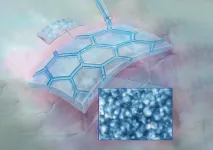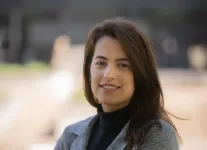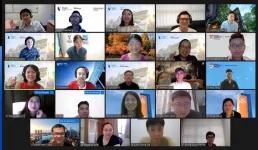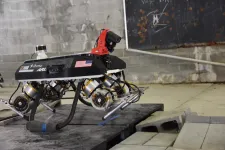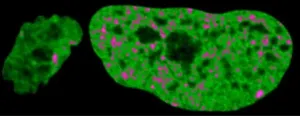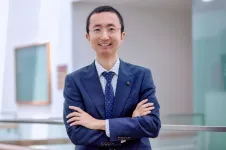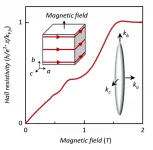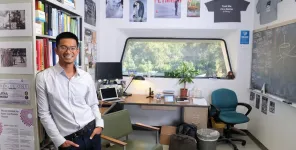Spiders can sniff out and avoid killer ants, SFU study finds
2021-06-02
(Press-News.org) Spiders avoid building webs near European fire ants, their natural predators, by sensing the chemicals they give off in the environment, Simon Fraser University researchers have found.
The findings, published recently in Royal Society Open Science, give us a peek inside the enduring struggle between spiders and ants, and could lead to the development of natural repellents for homeowners worried about unwanted eight-legged guests.
Many ants prey on spiders, suggesting that web-building spiders may avoid locations near ant colonies or frequented by foraging ants. The research team, led by SFU biological sciences PhD candidate Andreas Fischer, hypothesized that spiders instinctively know to avoid building webs in these danger areas by sensing chemical cues left behind by predatory ants.
Researchers tested the theory by exposing filter paper to several species of ants and placing it in a multi-chambered habitat of four different species of spiders. Filter papers without ant semiochemicals were put in another chamber to see which area the spiders would prefer.
They found that the chemical deposits of European fire ants specifically, which are known to be aggressive omnivorous scavengers and prey on many invertebrates, had a deterrent effect on all tested spider species. The spiders chose to stay in the chamber that had no chemical trace of ants nearby.
Given how much time and energy spiders put into building their webs, Fischer said it makes sense that spiders in the wild would pick locations that have fewer threats to their survival.
Meanwhile, people's fear of spiders has led to the development of many insecticides and other chemical products that claim to repel spiders. But most of them have proven largely ineffective because spiders are able to abandon their webs and rebuild elsewhere. Harnessing the natural chemicals given off by their natural predators could help create more effective repellents for homeowners. Researchers warn against using European fire ants, an invasive species, themselves as pest control.
INFORMATION:
The research team also included SFU professor Gerhard Gries, undergraduate student Tea Dong and University of Toronto's Yerin Lee.
AVAILABLE SFU EXPERTS
ANDREAS FISCHER, PhD candidate, Department of Biological Sciences | afischer@sfu.ca
CONTACT
MATT KIELTYKA, SFU Communications & Marketing
236.880.2187 | matt_kieltyka@sfu.ca
Simon Fraser University
Communications & Marketing | SFU Media Experts Directory
778.782.3210
ELSE PRESS RELEASES FROM THIS DATE:
2021-06-02
The future of electronic displays will be thin, flexible and durable. One barrier to this, however, is that one of the most widely used transparent conductors for electronic displays--indium tin oxide (ITO)--doesn't perform as well on larger areas and can crack and break down with wear. Indium is also a rare earth mineral, which is relatively scarce, and the process to create ITO requires high energy consumption and expensive equipment.
One emerging alternative is metal "microgrid" conductors. These microgrids can be customized to their application by varying the microgrid width, pitch and thickness, and they can be made with a variety of metals.
New research from the University of Pittsburgh Swanson School of Engineering ...
2021-06-02
Researchers have demonstrated "giant flexoelectricity" in soft elastomers that could improve robot movement range and make self-powered pacemakers a real possibility. In a paper published this month in the Proceedings of the National Academy of Sciences, scientists from the University of Houston and Air Force Research Laboratory explain how to engineer ostensibly ordinary substances like silicone rubber into an electric powerhouse.
What do the following have in common: a self-powered implanted medical device, a soft human-like robot and how we hear sound? The answer as to why these two disparate technologies and biological phenomena ...
2021-06-02
SMU Office of Research & Tech Transfer - Whether they are in the technology or oil sector, selling shoes or healthcare products, for many companies, green is the new black. While maximising profit might have been the sole priority for most businesses a decade ago, these days it is common for mission-oriented companies to pursue the 'triple bottom line' of people, planet and profit, particularly through corporate social responsibility (CSR) efforts.
While such efforts are commendable, some investors remain primarily concerned about whether firms can do well by doing good; in other words, whether CSR actually can increase a company's value. For instance, CSR activities could enhance brand image and improve customer loyalty, or even make it easier to attract and retain talent, leading to ...
2021-06-02
ABERDEEN PROVING GROUND, Md. - A new formula from Army scientists is leading to new insights on how to build an energy-efficient legged teammate for dismounted warfighters.
In a recent peer-reviewed PLOS One paper, the U.S. Army Combat Capabilities Development Command, known as DEVCOM, Army Research Laboratory's Drs. Alexander Kott, Sean Gart and Jason Pusey offer new insights on building autonomous military robotic legged platforms to operate as efficiently as any other ground mobile systems.
Its use could lead to potentially important changes to Army vehicle development. Scientists said they may not know exactly why legged, wheeled and tracked ...
2021-06-02
BROOKLYN, New York, Wednesday, June 2, 2021 - Perovskite solar cells have progressed in recent years with rapid increases in power conversion efficiency (from 3% in 2006 to 25.5% today), making them more competitive with silicon-based photovoltaic cells. However, a number of challenges remain before they can become a competitive commercial technology.
Now a team at the END ...
2021-06-02
The organization of the human genome relies on physics of different states of matter - such as liquid and solid - a team of scientists has discovered. The findings, which reveal how the physical nature of the genome changes as cells transform to serve specific functions, point to new ways to potentially better understand disease and to create improved therapies for cancer and genetic disorders.
The genome is the library of genetic information essential for life. Each cell contains the entire library, yet it uses only part of this information. Special types of cells, such ...
2021-06-02
SMU Office of Research & Tech Transfer - Short selling often gets a bad rap because it is a type of trade that bets against the success of a firm. In essence, short selling allows investors to borrow stock from a broker to sell into the market with the hope of buying the stock back at a cheaper price, thus, profiting on the difference between the sell and buy prices. Because of this practice, short selling is sometimes seen as a controversial tactic.
Furthermore, speculative short selling attacks are concerning as it can put downward pressure on ...
2021-06-02
The quantum Hall effect traditionally only plays a role in two-dimensional electron systems. Recently, however, a three-dimensional version of the quantum Hall effect was described in the Dirac semimetal ZrTe5. It has been suggested that this version results from a magnetic field-induced Fermi surface instability that transforms the original three-dimensional electron system into a stack of two-dimensional electron systems. Now scientists at the Max Planck Institute for Chemical Physics of Solids in Dresden, at the Technical University of Dresden, at the Brookhaven National Laboratory in New York, at the Helmholtz Center Dresden-Rossendorf, the Max Planck Institute ...
2021-06-02
Boulder, Colo., USA: GSA's dynamic online journal, Geosphere, posts articles online regularly. Locations and topics studied this month include the Moine thrust zone in northwestern Scotland; the Eastern California shear zone; implementation of "OpenTopography"; the finite evolution of "mole tracks"; the southern central Andes; the work of International Ocean Discovery Program (IODP) Expedition 351; and the Fairweather fault, Alaska, USA. You can find these articles at https://geosphere.geoscienceworld.org/content/early/recent.
Detrital-zircon analyses, provenance, and ...
2021-06-02
RIVERSIDE, Calif. -- As its name suggests, dark matter -- material which makes up about 85% of the mass in the universe -- emits no light, eluding easy detection. Its properties, too, remain fairly obscure.
Now, a theoretical particle physicist at the University of California, Riverside, and colleagues have published a research paper in the Journal of High Energy Physics that shows how theories positing the existence a new type of force could help explain dark matter's properties.
"We live in an ocean of dark matter, yet we know very little about what it could be," said Flip Tanedo, an assistant professor of physics and astronomy and the paper's senior author. "It is one of the most vexing known unknowns in nature. ...
LAST 30 PRESS RELEASES:
[Press-News.org] Spiders can sniff out and avoid killer ants, SFU study finds
